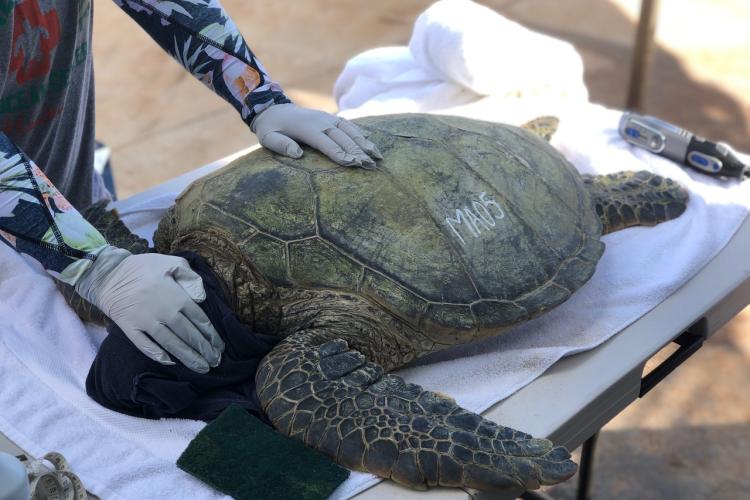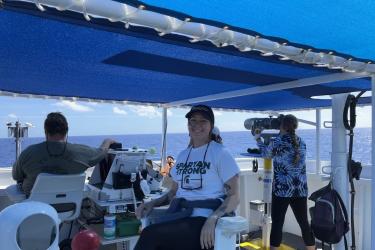One morning at the Maui Ocean Center (MOC) Marine Institute, I was counting and measuring the fishing line in the Institute’s fishing line collection bins when the turtle phone rang. A small juvenile green sea turtle had been observed swimming nearshore, entangled in fishing line. A monofilament fishing line was wrapped tightly around the turtle’s front flipper causing it to self-amputate, leaving it only attached to the body by the fishing line.
The MOC Marine Institute’s director, Tommy Cutt, immediately responded to the call. Tommy called back to the office and asked me and the sea turtle response team to prepare a carrier and the appropriate medical supplies.
The team picked up and transported the turtle to MOC Marine Institute, where I assisted with cleaning and bandaging the missing flipper. Getting to handle the turtle was a unique feeling to me because most people only see turtles from a distance. Part of my job was helping to make sure that the turtle remained calm and safe. I kept one hand on the turtle’s carapace (shell) and placed a small towel over its head to help it calm. My adrenaline was running and I wanted to freak out, but my training taught me that the highest priority is the safety of yourself and the turtle. Allowing your adrenaline to take over wouldn’t help you or the turtle.
When turtles require surgery or veterinary care they are flown to Honolulu to be seen by NOAA’s veterinary team. Tommy Cutt had contacted our partners at NOAA and made arrangements with Hawaiian Air Cargo to fly the turtle to them. We removed all of the fishing line, bandaged the turtle’s wound, and prepared it for transport. The turtle was loaded into our response vehicle and brought to the airport.
NOAA staff at the Pacific Islands Fisheries Science Center conducted a successful surgical flipper amputation and rehabilitative care. Afterward, their sea turtle stranding response coordinator, Shandell Brunson, let us know that the turtle had recovered from its injury and was now ready for release. The turtle flew back to the airport on Maui, where we picked it up the next day, and then headed straight to the beach to return it to the ocean.
This response will always be special to me because I was able to assist in bandaging the turtle’s wound and helping it return to the ocean. This experience helped me to learn how to better handle high stress situations by showing me the best thing you can do is to remain calm. Being able to calm down in a high stress situation helped to give me the confidence that I could handle more turtle rescues in the future.
More About Sea Turtle Stranding Response
I’d like to explain some background to this story and give you some details on my day-to-day work as a student assistant.
Under the U.S. Fish and Wildlife Service Permit #TE-72088A-2 and in partnership with NOAA Fisheries, MOC Marine Institute responds to public reports of sick, injured, distressed, or otherwise compromised sea turtles on the island of Maui.
Residents and visitors of Maui report turtles in need of help through the NOAA Fisheries Statewide Stranding, Entanglement, and Reporting Hotline: 888-256-9840.
The first part of our sea turtle response is to answer the hotline (a.k.a. “turtle phone”), determine whether the turtle is dead or alive, and ask questions to assess its condition. Many of the calls that we receive are about turtles that are basking, which is when a turtle rests on the shore—a normal behavior for sea turtles in Hawaiʻi. These calls provide us with the opportunity to educate the general public. We also receive calls about serious injuries such as entanglement in monofilament fishing line, fibropapillomatosis (tumors), or boat strikes.
We write reports for all calls, including basking turtles and stranding cases. For the more severe cases of sea turtle reports, a sea turtle response team assembles and works with the NOAA Pacific Islands Fisheries Science Center’s Marine Turtle Biology and Assessment Program.
Each response is unique and individualized for each turtle. But for any response, we photograph the turtle's carapace, lateral sides, face, and any abnormalities. We also use a soft measuring tape to measure the curved carapace length.
In some cases like this one, when the injuries are too severe for us to handle, the turtle is transported to NOAA Fisheries on Oʻahu. Once a turtle from Maui has been treated, it is tagged and returned to Maui for release.
Tagging Sea Turtles
I have assisted with two types of tagging at the MOC Marine Institute: mototool, or shell etching, and passive integrated transporter (PIT) tagging, which is similar to a microchip that is used in cats and dogs. Before mototool tagging, we clean the turtle’s carapace with a green scrub pad to remove any algae. A turtle’s shell is made of keratin, the same tissue that makes up human hair and nails. To mototool tag, we use a dremel tool to safely etch the shell with the initials of the island and the number of the stranding case that year (for example, MA for Maui and 05 for the fifth turtle stranding case in 2020). This is the same tool used by nail technicians when getting a manicure. The groove is then filled with white paint that is harmless to the turtle but makes it easier for future observers to view the turtle's number without disturbing it. These numbers will last up to a year, depending on the turtle's growth rate.
Sea turtles also receive a PIT tag before release. We insert them under the skin into each of the turtle’s rear flippers. These tags are about the size of a grain of rice and can be detected by a scanner. We record the unique code (alphanumeric or numeric) of each tag in the stranding report. The main benefit of PIT tags is that they are nearly permanent; however, one must have the appropriate scanner to read them.
These tags do not have tracking devices in them, so after we release the turtle, it is up to people sighting the turtle to report its location, which is where the mototool number comes in very handy.
Fishing Line Collection Bins
A fishing line recycling bin on the Kealia Coastal Boardwalk, Kihei, HI.
Monofilament fishing line entangles sea turtles and their habitat, and is currently their top threat. The MOC Marine Institute installed 26 fishing line recycling bins throughout the island at popular nearshore fishing locations, primarily in Lahaina and Kihei. They provide fishers with an easily accessible way to dispose of their fishing line. The recycling bins are made from black PVC pipe, and are easily hung on fences or signs using a metal zip tie. On the top of the pipe is a curved mouth to deposit the line and at the bottom is a detachable piece that we can unscrew to collect the line, which we do every 2 weeks.
One challenge is that people often mistake them for rubbish bins, so we added “No Trash” stickers. We still separate rubbish from the fishing line. We then take the line back to MOC Marine Institute to weigh it as a way to measure the length. After measuring the fishing line and recording it in a MOC Marine Institute database, we put it into a box and ship it to a facility that recycles the line into new items. In 2019, we recorded more than 6 miles of fishing line in the recycling bins on Maui.
Meet the Blogger
At UH Maui, Sanoma is currently completing her bachelor’s degree in Sustainable Science Management, along with the completion of the Marine Option Program. She began her internship with the MOC Marine Institute in January 2019 to learn about sea turtle stranding response and marine debris reduction. Her internship has brought her numerous opportunities to experience turtle stranding response and marine debris reduction initiatives. She assists in sea turtle stranding response activities and data collection, procedures and protocols for sea turtle husbandry, and MOC Marine Institute’s fishing line recycling project. As a student assistant through a collaboration with NOAA Fisheries, she is continuing her work on sea turtle stranding response and marine debris reduction on the island of Maui.
Her training and experience with sea turtle response through MOC Marine Institute and NOAA Fisheries has made her feel comfortable in the field when handling sea turtles. “I am glad that I was able to have such experiences and be a part of a team that is making a positive impact in the marine world.”






